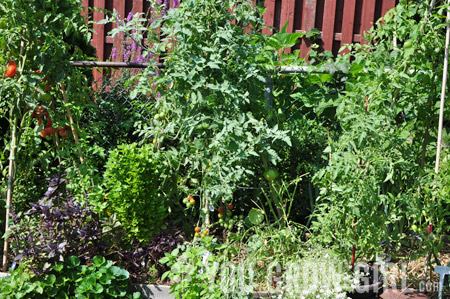
How I prune my tomatoes is a popular question and while I was out doing that work yesterday evening, I figured it was high time that I address it here on the site.
There are countless ways to approach tomato culture, all or at least most of which are probably right and good. I am not one to force my methods down anyone’s throat — you are doing it right if it works for you. I’ve experimented with a lot of different methods over the years, sometimes intentionally and sometimes due to neglect (do not underestimate the learning that comes from doing nothing), and have made adjustments to my approach along the way. I have also adjusted based on different varieties and tomato types. The following is a general picture of how I do things to date.
To begin, I do not prune dwarf or determinate (bushing) varieties unless they are showing signs of disease. The following only applies to indeterminate (vining) varieties. That said, wild currant varieties are an exception to the rule. I try to keep them trained as best I can early in the season, but there is always a point where their growth is so fast and furious that I just let them be and try to keep them staked to the best of my ability. I find that they tend to be more disease resistant than many other types.
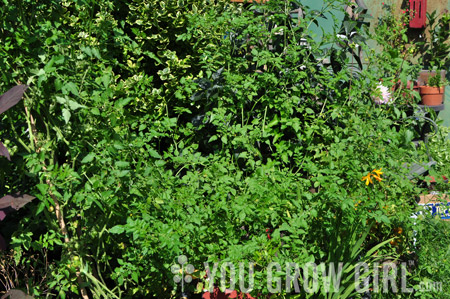
This currant variety is so wild and out of control that I just gave up entirely and am using a bench to prop it up off of the ground. So far so good.
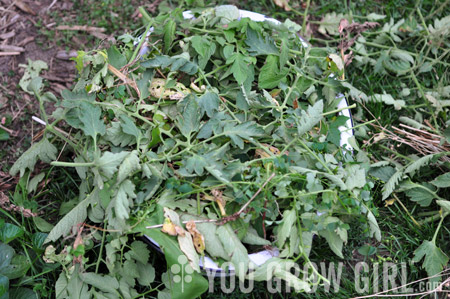
Yesterday’s prunings.
How I Prune
Early in the season, when the plants are establishing themselves outdoors and producing lots of leaves, I remove all of the lower leaves to establish one main stem, tying that stem up a stake as it grows. I also remove all “suckers” (new stems that come up in the elbow between branches). Of course, sometimes I am not diligent enough or miss a stem or sucker and the next thing you know I have a new stem with fruit. I’m not a perfectionist and find that it’s not a big deal when this happens. It just makes it a little bit harder to stake using my tripod system.
I underplant with lettuce (early in the season) as well as basil and other companion herbs and edible flowers. They attract pollinators, make good use of the space (more food!), and serve to protect the soil from hot sun as the summer heats up.
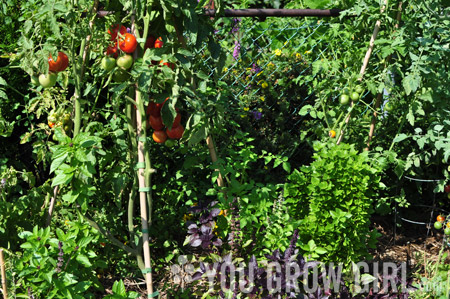
Several basil varieties growing underneath my tomatoes.
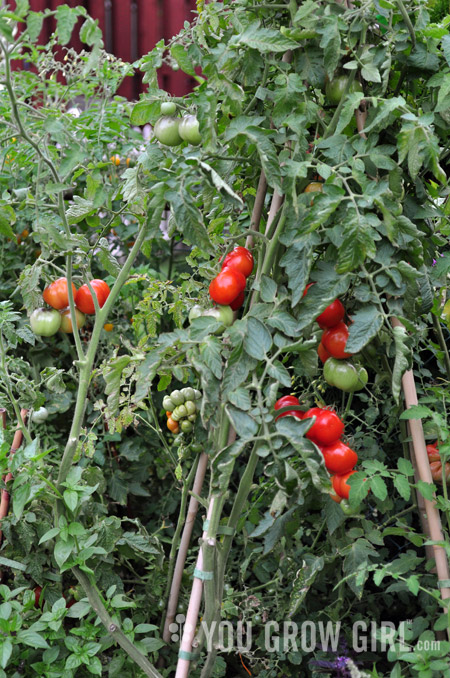
Here’s a closer view of the lower portion of the plants. I am in love with velcro ties. It comes on a roll that I cut to the lengths that I need. I save and reuse the ties over and over.
Later in the season, once fruiting has begun, I tend to stop removing the lower leaves and eventually even the suckers. I used to be diligent about removing all suckers as conventional wisdom held that suckers will reduce the amount of fruit gleaned. Over the years I have loosened up and have found that allowing suckers to develop higher up on the plant has not had a negative impact on my harvest. Allowing them to get out of hand does however, create a mass of unruly stems and leaves that is difficult to train and which can lead to disease (more on that below).
Throughout the season, I remove excess foliage wherever air flow is poor or where signs of disease occur. My goal is to leave enough foliage to feed the plants and act as a sun canopy that protects the fruit from sun scald, while ensuring that air is able to circulate through the leaves easily.
As the season draws closer to the first frost date, I chop off the highest stems in order to direct the plant’s remaining energy into producing ripe fruit. What this means is that I remove any flowering stems that I know will not make it to maturity before the frosts come and kill the whole thing dead. This is a good way to glean more ripe fruit as the plant is not working to produce tiny, immature green things that aren’t developed enough to preserve or eat.
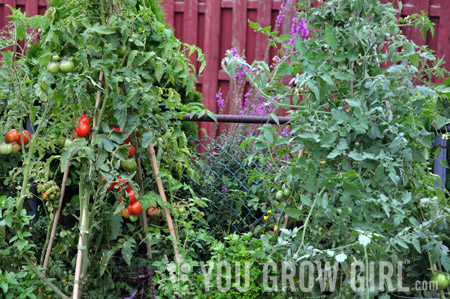
Why I Prune
To Provide Good Air Flow: This is the number reason why I both prune and stake. The two go hand in hand. Toronto summers can be very hot and humid. I have found over time that plants that are allowed to sprawl willy nilly become infected with fungal diseases more easily and even those that are staked but not pruned will also show signs of disease around midsummer when humidity is highest. Removing the bottom leaves ensures that there is good air flow underneath the plant and helps avoid backsplash that can occur when watering. It also makes it easier for me to direct water flow and see exactly what is going on with the soil.
To Protect the Fruit: I have allowed plants to sprawl on the ground, but I find that this leads to a loss of fruit to critters such as slugs, earwigs, and the like. Slugs will crawl up the plant to get to the fruit, but why make it easy for them?
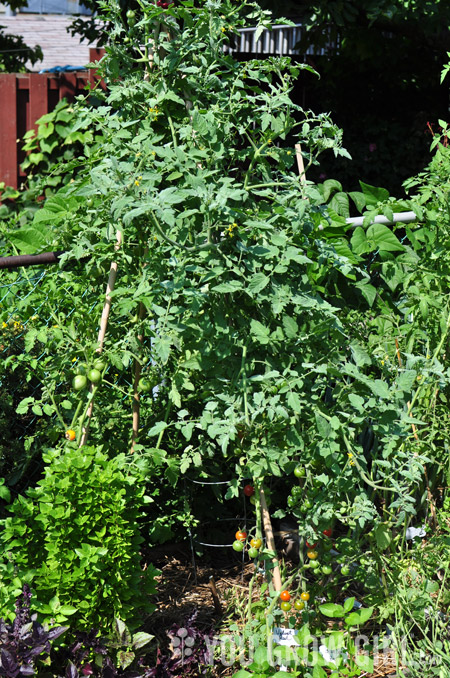
I love the velvety soft, silver foliage of this indeterminate cherry tomato called ‘Velvet Red.’ It’s leaves are inviting to touch. I always put the most interesting varieties out front where they will be seen. Even tomato plants can be pretty.
To Make Better Use of Space: As I mentioned above, pruning the bottom growth provides ample space to grow my favourite herb crops. Interplanting in this way ensures that I get a lot of food out of a small raised bed.
Aesthetics: Trained and pruned tomatoes with beautiful, colourful herbs and edible flowers growing underneath simply looks nicer. Neat and tidy but still wild. Enough said.
Great info, thank you. I’ve recently become more diligent about pruning my indeterminates. Like you, I also go a little lax later in the season and it seems fine.
Side note: my little ‘Hahms G’ (as I call them) plants that I’m growing from your seed are doing GREAT… so much fruit set. Just need some warm days in SF to get ’em ripe. I may be tempted to try saving tomato seeds for the first time this year, as they’re becoming a must-have.
Good advice. I love how crazy the vines of the small currant tomatoes get. Snackscaping…along with asparagus, shell peas, and raspberries.
Here in Calgary, where we have a way too short season, i let the main stem and the first two side-suckers grow (each with their ouwm sturdy stake), so i have a three-headed plant. This way i get three times as many early clusters of tomatoes – it’s usually only these ones (and maybe the next set of fruit) that have time to ripen on the vine. It works well in this climate, and i also have three times as many green ones to ripen in the house into November. 4C this morning…nice and warm now.
cheers,
jake
p.s.
wow, those ripe tomatoes look great. it looks like a great crop!
This is great advice to prune the top off, so the fruit ripens. I always forget to do this. I’m going out there right now to do it. Thanks for the reminder:)
Wonderful instructive post! And tomato velcro is the greatest thing ever.
You’re so right about the learning that comes from doing nothing! My husband and I spent all of yesterday’s afternoon in our tiny greenhouse, sweating and swearing, because I had planted way to many tomato plants in there and neglected to prune them, so in the end you couldn’t even get in without a machete (okay, pruning scissors …). Now it all looks quite tidy again, but we have lost a lot of fruit to snails, because they were all down on the ground. So, for next time: less plants, more pruning!
Great advice and complete, thank you! I will improve my technique next year!
Perfect timing! I’ve occasionally pruned my tomatoes near the end of the summer thinking that the flowers and small fruits are using energy that I’d rather see go to the already growing tomatoes. But I didn’t know if I should actually be doing this because I hadn’t heard other people say that they’ve done it. Now I can go out in the garden this week and prune those tops without worry! Thanks!
Thank you, thank you! I left my tomatoes on the ground this year because I really wasn’t sure what to do with them. I predictably lost a lot of fruit. So excited to try this next year. :-)
Pruning tomato plants is a difficult subject for me. I’ve never seen any evidence that it helps fruit ripen sooner, although others urgently believe that it is true. How do you know that taking off the top branches at the end of the year helps the tomatoes to ripen? I’ve heard that stressing the roots is a better method. I always have trouble ripening my heirlooms. There’s just not enough hours of sun here in New Hampshire.
I used to hard prune my tomatoes but over the years I found that a lighter approach is kinder to the plants and I get much better results. I also underplant with basil, marigolds and purslane. Love your staking system.
The reason I prune the top of my tomato plants in early fall is so the every last bit of warm sunlight can reach into the plant and ripen what few greenies are left.
Thank you for that thoughtful explanation. I’ve been trying to find my way with tomato staking and pruning and I realize the wisdom of your conclusions.